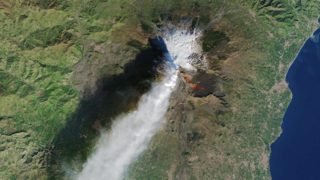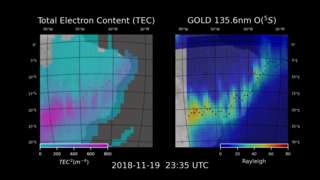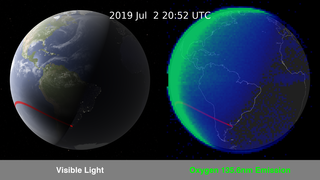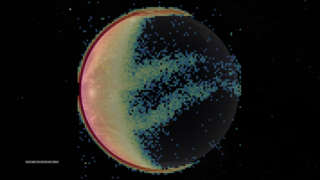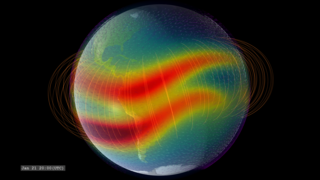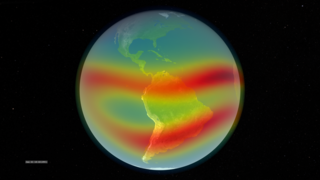Earth
Sun
ID: 4617
This is a visualization of the Equatorial Fountain process in the ionosphere, whereby ions are driven away from the equator forming ion density enhancements to the north and south of the equator. This visualization is depicted near 50 degrees west longitude, where the magnetic equator crosses the geographic equator. Magnetic field lines near Earth are represented by the gold lines. Particles appear in a blue-white flash, representing the point where atoms are ionized, becoming positively charged and releasing an electron. Now these charged particles can 'feel' the near-Earth electric and magnetic fields. Their motion becomes a combination of circular gyromotion (see Plasma Zoo: Gyromotion in Three Dimensions) due to the magnetic field and E-cross-B drift (see Plasma Zoo: E-cross-B Drift). At higher altitudes, the electric field is weaker, reducing the vertical motion, and the ion motion becomes dominated by the magnetic field and gravity, allowing the ion to 'slide' down the magnetic field line back to Earth. At lower altitudes, the ions combine with free electrons in a process called recombination, represented by a red flash and fading of the particle trail.
A slice of data from the IRI (International Reference Ionosphere) model represents the density of singly-ionized oxygen atoms is faded-in to compare to the particle motion. Red represents high ion density, green represents low ion density. The camera finally pulls out from Earth, providing an overview of the enhanced ion density (red) above and below the magnetic equator on the dayside of Earth. This enhancement was discovered by Edward Appleton in 1946.
The Fountain effect is just one of the many of complex processes which occur in the layer of thinning atmosphere that forms Earth's interface to the space environment. A conceptual inventory of some of these processes are presented in the graphic at Terrestrial Atmosphere ITM Processes.
What creates the dayside near-Earth electric field? As the sun warms Earth's atmosphere during the day, the temperature and pressure differences create wind flows. In the upper atmosphere, where the solar ultraviolet photons also break atoms into negative-charged electrons and positive-charged ions, these winds carry the charges creating currents and electric fields. The major current from this process is called the equatorial electrojet and travels along the magnetic equator (not quite aligned with the geographic equator). This motion of charges also creates a west-to-east directed electric field.
Are the particles in this visualization at a realistic scale? The particles in this visualization are generated to be representative of the motion in the fountain effect to the appropriate altitudes and latitudes, but items such as the size of the gyromotion, and the particle size, are not to be regarded as physically accurate.

Interface to Space: The Equatorial Fountain
A slice of data from the IRI (International Reference Ionosphere) model represents the density of singly-ionized oxygen atoms is faded-in to compare to the particle motion. Red represents high ion density, green represents low ion density. The camera finally pulls out from Earth, providing an overview of the enhanced ion density (red) above and below the magnetic equator on the dayside of Earth. This enhancement was discovered by Edward Appleton in 1946.
The Fountain effect is just one of the many of complex processes which occur in the layer of thinning atmosphere that forms Earth's interface to the space environment. A conceptual inventory of some of these processes are presented in the graphic at Terrestrial Atmosphere ITM Processes.
What creates the dayside near-Earth electric field? As the sun warms Earth's atmosphere during the day, the temperature and pressure differences create wind flows. In the upper atmosphere, where the solar ultraviolet photons also break atoms into negative-charged electrons and positive-charged ions, these winds carry the charges creating currents and electric fields. The major current from this process is called the equatorial electrojet and travels along the magnetic equator (not quite aligned with the geographic equator). This motion of charges also creates a west-to-east directed electric field.
Are the particles in this visualization at a realistic scale? The particles in this visualization are generated to be representative of the motion in the fountain effect to the appropriate altitudes and latitudes, but items such as the size of the gyromotion, and the particle size, are not to be regarded as physically accurate.

References
- NOAA/National Geophysical Data Center. International Geomagnetic Reference Field
- Erwan Thebault, Christopher C. Finlay, et al. International Geomagnetic Reference Field: the 12th generation. Earth, Planets and Space 67:79 (2015)
- Dieter Bilitza. The International Reference Ionosphere - Status 2013. Advances in Space Research, Volume 55, p. 1914-1927 (2015)
- Douglas P. Drob, John T. Emmert, et al. An update to the Horizontal Wind Model (HWM): The quiet time thermosphere. Earth and Space Science, vol. 2, issue 7, pp. 301-319
- Edward V. Appleton. Two Anomalies in the Ionosphere. Nature, Volume 157, pp. 691 (1946)
- E. N. Bramley and M. Peart. Diffusion and electromagnetic drift in the equatorial F2-region. Journal of Atmospheric and Terrestrial Physics, vol. 27, pp. 1201-1211 (1965)
- R.J. Moffett & W.B. Hanson. Effect of Ionization Transport on the Equatorial F-Region. Nature 206, pp705-706 (1965)
Used Elsewhere In
Related
Visualization Credits
Tom Bridgman (Global Science and Technology, Inc.): Lead Visualizer
Jeff Klenzing: Scientist
Sarah L. Jones (NASA/GSFC): Scientist
Laurence Schuler (ADNET Systems, Inc.): Technical Support
Ian Jones (ADNET Systems, Inc.): Technical Support
Jeff Klenzing: Scientist
Sarah L. Jones (NASA/GSFC): Scientist
Laurence Schuler (ADNET Systems, Inc.): Technical Support
Ian Jones (ADNET Systems, Inc.): Technical Support
Please give credit for this item to:
NASA's Scientific Visualization Studio
NASA's Scientific Visualization Studio
Short URL to share this page:
https://svs.gsfc.nasa.gov/4617
Data Used:
Note: While we identify the data sets used in these visualizations, we do not store any further details nor the data sets themselves on our site.
This item is part of this series:
Interface to Space
Keywords:
SVS >> Geomagnetic Field
GCMD >> Earth Science >> Sun-earth Interactions >> Ionosphere/Magnetosphere Particles
GCMD >> Location >> Ionosphere
SVS >> Hyperwall
NASA Science >> Earth
NASA Science >> Sun
GCMD >> Earth Science >> Sun-earth Interactions >> Ionosphere/Magnetosphere Dynamics >> Electric Fields/electric Currents
GCMD >> Earth Science >> Sun-earth Interactions >> Ionosphere/Magnetosphere Dynamics >> Magnetic Fields/magnetic Currents
SVS >> Appleton anomaly
GCMD keywords can be found on the Internet with the following citation: Olsen, L.M., G. Major, K. Shein, J. Scialdone, S. Ritz, T. Stevens, M. Morahan, A. Aleman, R. Vogel, S. Leicester, H. Weir, M. Meaux, S. Grebas, C.Solomon, M. Holland, T. Northcutt, R. A. Restrepo, R. Bilodeau, 2013. NASA/Global Change Master Directory (GCMD) Earth Science Keywords. Version 8.0.0.0.0
https://svs.gsfc.nasa.gov/4617
Data Used:
International Geomagnetic Reference Field also referred to as: IGRF-2012
ModelInternational Reference Ionosphere also referred to as: IRI 2016
ModelThis item is part of this series:
Interface to Space
Keywords:
SVS >> Geomagnetic Field
GCMD >> Earth Science >> Sun-earth Interactions >> Ionosphere/Magnetosphere Particles
GCMD >> Location >> Ionosphere
SVS >> Hyperwall
NASA Science >> Earth
NASA Science >> Sun
GCMD >> Earth Science >> Sun-earth Interactions >> Ionosphere/Magnetosphere Dynamics >> Electric Fields/electric Currents
GCMD >> Earth Science >> Sun-earth Interactions >> Ionosphere/Magnetosphere Dynamics >> Magnetic Fields/magnetic Currents
SVS >> Appleton anomaly
GCMD keywords can be found on the Internet with the following citation: Olsen, L.M., G. Major, K. Shein, J. Scialdone, S. Ritz, T. Stevens, M. Morahan, A. Aleman, R. Vogel, S. Leicester, H. Weir, M. Meaux, S. Grebas, C.Solomon, M. Holland, T. Northcutt, R. A. Restrepo, R. Bilodeau, 2013. NASA/Global Change Master Directory (GCMD) Earth Science Keywords. Version 8.0.0.0.0
